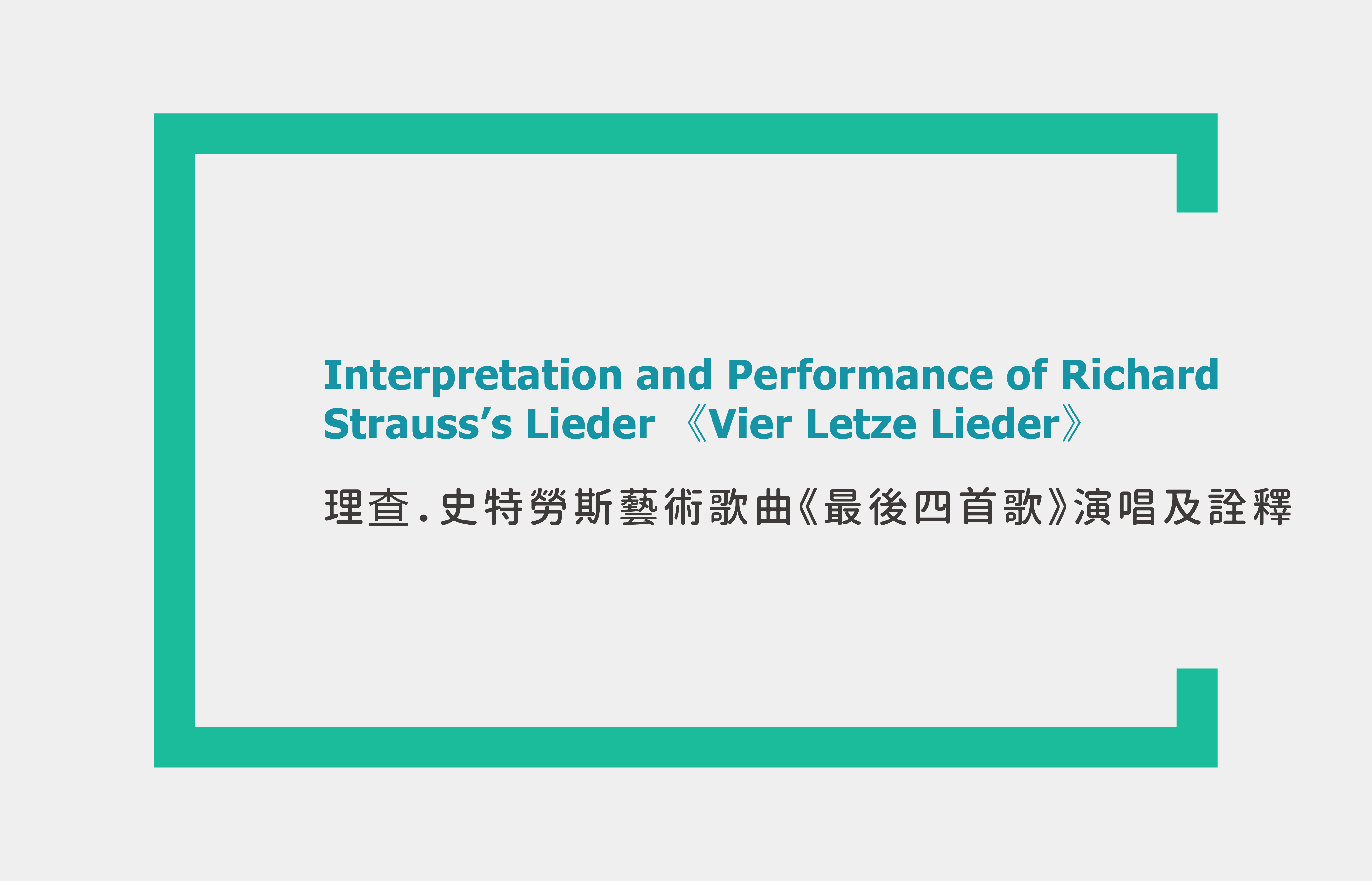理查.史特勞斯藝術歌曲《最後四首歌》演唱及詮釋
Interpretation and Performance of Richard Strauss’s Lieder 《Vier Letze Lieder》
中文摘要
理查・史特勞斯(Richard Strauss,1863-1949)是晚期浪漫樂派的重要音樂家之一,一生中所創兩百多首的藝術歌曲,結合了古典及浪漫的風格,呈現出獨特的風格,而歌劇及管弦樂作品亦是如此。本解說報告將選取史特勞斯晚年最重要的作品之一:《最後四首歌》(Vier Letzte Lieder);藉由這四首歌所運用之手法、詩詞以及情感表達的方式、詮釋等,來探究史特勞斯晚期音樂的特色以及即將死亡的他的心境。
《最後四首歌》中依演唱順序分別為:〈春天〉(Frühling)、〈九月〉(September)、〈入睡時分〉(Beim Schlafengen)、〈在晚霞中〉(Im Abendrot)。〈春天〉描述了晚年史特勞斯對於春天的期盼及春天到來的景象;〈九月〉將季節延續到初秋的惆悵,表達出史特勞斯對於生命變化無常的無奈;〈入睡時分〉進入到休息的時刻,身心俱疲的史特勞斯渴望安靜地休息在無拘束的夜裡;最後的〈在晚霞中〉為史特勞斯寫給他及妻子的輓歌,懷念共同的幸福時光同時也象徵著人生的尾聲。
本文將分作五個章節:第一章包括研究動機、研究目的及方法;第二章敘述史特勞斯的生平以及他的音樂風格;第三章為《最後四首歌》之創作背景以及詩人的介紹,內容包括史特勞斯的創作背景以及詩人的生平、背景等;第四章則是詳細解說《最後四首歌》在樂曲上的分析以及感情上的詮釋;最後第五章則是綜合上述所述之結論,並於附錄附上此套曲之總譜。
Abstract
Richard Strauss(1863-1949)was an important post-romantic composer. He composed nearly 200 lieder, along with operatic and orchestral works, combined the classical and romantic styles, and brought about his own unique style. This study will examine one of Richard Strauss’s important works during his late period: Vier Letzte Lieder. By examining Strauss compositional technique in Vier Letzte Lieder, we can further reveal his thoughts on music and life near his death.
The order of Vier Letzte Lieder is by the first piece Frühling, second piece September, third piece Beim Schlafengen, and lastly Im Abendrot. Frühling was descripted Richard Strauss looked forward to the coming of spring. Secondly, September was showing Richard Strauss feel helpless against the changes of weather. Beim Schlafengen was telling that Richard Strauss was trying to rest peacefully with his exhausted body and life. Lastly, Im Abendrot was a piece which Richard Strauss wrote for his wife as an elegy, for all the sweet memories he had with his wife till the end of life.
This study contains five sections: Chapter 1 contains the research motivation, purposes and methods. Chapter 2 introduces Richard Strauss’s life and his musical style. Chapter 3 explains the background of Vier Letzte Lieder and introduces the poets, whose poems are set by Strauss. Chapter 4 analyzes Vier Letzte Lieder in detail, and gives recommendations for interpretation. The last chapter presents the conclusion.
參考文獻
中文書目
丁晏海。《德文藝術歌曲中文曲目集》。臺南:國家圖書館出版,2005。
尼斯(Nice,David)。《偉大作曲家群像-理查・史特勞斯》。劉瑞芬 主譯。第一版。臺北:智庫出版,1996。譯自The illustrated lives of the great composers:Richard Strauss。
目黑 諄。《作曲家別名曲解說珍藏版》。林勝儀 譯。第一版。臺北:美樂出版,2000。
李映荻 編譯。《德國文學入門》。臺北:志文出版社,1975。
許鐘榮。《古典音樂400年 浪漫樂派的巨星》。臺北:錦繡出版社,1999。
許鐘榮 。《古典音樂400年 浪漫派樂曲賞析(三)》。臺北:錦繡出版社,1999。
楊沛仁。《音樂史與欣賞》。臺北:美樂出版社,2001。
赫塞(Hesse,Hermann)。《鄉愁》。陳曉南 譯。再版。臺北:志文出版社,1978。譯自Peter Camenzind,1904。
臺灣中華書局股份有限公司及美國大英百科全書公司。《簡明大英百科全書中文版》。臺北:臺灣中華書局股份有限公司,1988。
劉志明。《西洋音樂史與風格》。臺北:全音樂譜出版社,1988。
賴偉峰、陳漢金 等。《發現理查・史特勞斯》。臺北:音樂時代,2006。
學位論文
宋怡慧。《理查・史特勞斯藝術歌曲之研究-以〈四首最後的歌〉(1948)為例》。臺南:國立臺南大學,2007。
施虹名。《理夏德・史特勞斯〈少女之花,作品編號22〉之解析》。高雄:國立中山大學,2007
黃子珊。《理查・史特勞斯〈少女之花〉詮釋報告》。臺南:國立臺南藝術大學,2010。
楊旻恩。《理查・史特勞斯四首藝術歌曲之研究與分析-以音樂會曲目為例》。花蓮:國立丁華大學音樂學系,2010。
外文書目
Boulby, Mark. Hermann Hesse: HIS MIND AND ART. New York: Cornell University Press, 1967.
Del Mar,Norman.Richard Strauss:a critical commentary on his life and works. New Yorl:Cornell University Press,1986.
Eichendroff,Joseph.Joseph von Eichendroff:Briefe,1794-1857:Text.Stuttgart: Verlag W.Kohlhammer,1992.
Osborne,Charles.The complete operas of Richard Strauss.New York:Da Capo Press,1991.
期刊
伍牧。〈理・查史特勞斯Richard Strauss 1864-1949〉。《音樂與音響》201(1990):17-23。
金慶雲。〈理查・史特勞斯的最後四首歌〉。《音樂與音響》96(1981):62-66。
席慕德。〈理查・史特勞斯(Richard Strauss 1864-1949)四首最後的歌“我們疲於漂泊,難道這就是死亡?”-艾興多夫〉。《古典音樂》3(1992):46-47。
蔡登法。〈理查・史特勞斯的天鵝之歌《最後四首歌》〉。《古典音樂》91(2000):96-105。
網路資源
古典啟示錄:< http://mypaper.pchome.com.tw/classic> (瀏覽日期:2014.10.5)
古典音樂漫談:(瀏覽日期:2014.10.14)
Poemhunter:< http://www.poemhunter.com/hermann-hesse/biography/>(瀏覽日期:2014.11.18)
Wikipedia:(瀏覽日期:2014.10.19)
樂譜
Vier Letzte Lieder.Alexander Street Press,LCC.1948.
喻宜萱 選編。《古斯塔夫・馬勒、理查・施特勞斯藝術歌曲選集》。北京:人民音樂出版社,2005。
